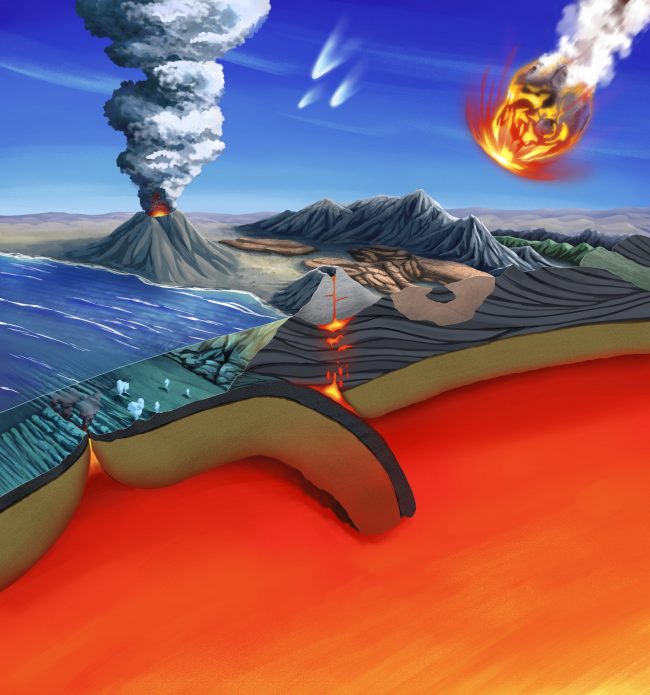
Scientists have been grappling for years with the question of methane on Mars. On Earth, methane is a life sign. But, on Mars, though visiting spacecraft have detected methane, the question of life is still open. Now move outward in space, beyond our own solar system, to worlds orbiting distant stars. Scientists at UC Santa Cruz said on March 28, 2022, that under the right circumstances, finding methane in the atmosphere of a rocky exoplanet might also indicate life.
These scientists just published a new study, which they said “assesses the planetary context” of methane – as a life sign – in an exoplanet’s atmosphere. They also talked about methane detection with respect to the James Webb Space Telescope, which will begin its observations later this year.
The scientists published their study on March 30, 2022, in the peer-reviewed journal Proceedings of the National Academy of Sciences.
What is methane?
Scientists refer to methane as a biosignature. It’s a colorless, odorless gas with the formula CH4. Methane is also a greenhouse gas. You might be familiar with methane on Earth as a component of natural gas. Our Earth stores a lot of methane underground and under the seafloor. Some animals, such as cows and sheep, expel methane as part of their digestive process.
In our own solar system, methane is commonplace on the gas giant planets, such as Jupiter. But, in those cases, the gas is a result of how these planets were born. In addition to Mars, mentioned above, Saturn’s moon Enceladus is also known to harbor methane. On both of those relatively nearby worlds, the source of methane isn’t entirely clear; we don’t know yet whether the methane is a sign of life.
Out among the distant stars, a biosignature of methane in an exoplanet atmosphere would be an intriguing, to say the least. And the James Webb Space Telescope should be able to detect methane in exoplanetary atmospheres if there is any to be found. Maggie Thompson of UC Santa Cruz said:
Oxygen is often talked about as one of the best biosignatures. But it’s probably going to be hard to detect with [Webb].

How methane makes a good biosignature
The scientists wanted to create a framework for assessing methane biosignatures that Webb might find. Previously, there was not an up-to-date, dedicated assessment of the planetary conditions needed for methane to be a good biosignature. Thompson said:
We wanted to provide a framework for interpreting observations, so if we see a rocky planet with methane, we know what other observations are needed for it to be a persuasive biosignature.
Life is not the only source of methane. Some of the non-biological sources are volcanoes, mid-ocean ridges, hydrothermal vents, tectonic subduction zones and comet or asteroid impacts. But because methane is unstable in the atmosphere, a planet with a methane-rich atmosphere would need to regularly replenish it. Joshua Krissansen-Totton of UC Santa Cruz said:
If you detect a lot of methane on a rocky planet, you typically need a massive source to explain that. We know biological activity creates large amounts of methane on Earth, and probably did on the early Earth as well because making methane is a fairly easy thing to do metabolically.
Telling biological sources apart from nonbiological sources
If the Webb telescope discovers methane in the atmosphere of a rocky world, astronomers can look to other clues to determine its origin. If the planet also shows an abundance of carbon monoxide, for example, outgassing from volcanoes may be to blame. Meanwhile, biological activity tends to consume carbon monoxide.
To look for potential biosignatures on another planet, the team concluded that important elements would include a rocky planet orbiting a sun-like star with a greater abundance of atmospheric methane over carbon dioxide. They would also need to rule out extremely water-rich planetary compositions. Thompson said:
One molecule is not going to give you the answer. You have to take into account the planet’s full context. Methane is one piece of the puzzle, but to determine if there is life on a planet you have to consider its geochemistry, how it’s interacting with its star, and the many processes that can affect a planet’s atmosphere on geologic timescales.
Eliminating methane-based false positives
The team has created guidelines for assessing methane biosignatures to avoid false positives. Krissansen-Totton said:
There are two things that could go wrong: You could misinterpret something as a biosignature and get a false positive, or you could overlook something that’s a real biosignature … This study is focused on the most obvious false positives for methane as a biosignature. The atmospheres of rocky exoplanets are probably going to surprise us, and we will need to be cautious in our interpretations. Future work should try to anticipate and quantify more unusual mechanisms for nonbiological methane production.
Bottom line: A team of scientists say that the Webb telescope could find methane around planets in our galaxy, which could be an indicator of life. They’ve provided a framework to help determine the methane’s true source.
Source: The case and context for atmospheric methane as an exoplanet biosignature











